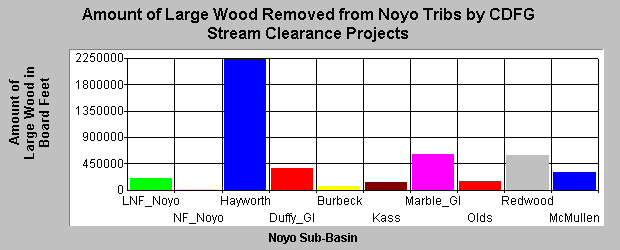Bibliography Background About KRIS
Stream Clearance
Mendocino Area Stream Clearance Projects: The First Phase of California Coastal Salmon and Steelhead Restoration
The State of California recognized in the late 1950s that it had a major fisheries crisis on its hands. Stream damage from the 1955 flood and previous timber harvest had North Coast streams choked with logging debris and silt ( CDFG Director Shannon speech, 1960 ). The causative factors for decline were thought to be "higher temperatures and siltation" which were linked to logging. The political climate was not right in the early 1960s for substantial logging reform, however. Instead "restoration" focused on one of the manifestations of industrial logging at the time: the large amount of debris left in streams after completion of logging operations. In some cases, this included large wood dating back to logging in the last century.
Stream alteration, in the form of large wood removal, was initiated on the Noyo River as a pilot project. Holman and Evans (1964) reported the strategy and cost associated with the project, but were not able to measure tangible benefits from the activity. They identified 296 log jams on 16 Noyo River tributaries and removed them over two years to "improve" over 36 miles of stream. "All these tributaries contained many log jams ranging in size up to 200 feet long and 50 feet wide. The authors stated that
"Contrary to popular belief, the principal benefit of log jam removal is not removal of impassable barriers. It is improvement of habitat by permitting scouring winter flows to remove silt and gravel deposited behind log jams. It is believed that both spawning conditions and food production are thus improved for anadromous fishes."
The apparent assumption underlying this approach is that sediment is limiting fisheries and that flushing it from the system will restore the stream channel to equilibrium. This strategy did not take into account that moderating sediment movement actually benefited downstream reaches by allowing them to at least retain patches of clean gravel. Large wood also provided roughness elements to sort bedload and create scour. The assumptions also apparently presumed sediment supply would decrease, but instead, additional logging generated more sediment. Large wood recruitment from riparian zones has also been reduced by timber harvest since the 1960s.

This chart shows an estimate of large wood (in board feet) removed from Noyo River tributaries as part of stream clearance projects. Data is from the Mendocino Redwood Company.
 The Jackson Demonstration State Forest contributed ArcView information to the KRIS Map project. This image shows the removal of large wood in the South Fork Noyo basin by decade. A USGS topo map is displayed as a backdrop. [142 kb]
The Jackson Demonstration State Forest contributed ArcView information to the KRIS Map project. This image shows the removal of large wood in the South Fork Noyo basin by decade. A USGS topo map is displayed as a backdrop. [142 kb]
Holman and Evans (1964) present a classic case of not following an adaptive management path. They admitted that they could not accurately quantify the amount of large wood that was removed from the stream because they were using Conservation Camp convicts labor, an inexpensive but poorly trained labor force. They noted that streams behind log jams had returned to grade but they had no mechanism to quantify the benefits to fish. Despite their inability to evaluate the results of this procedure, Holman and Evans (1964) recommended that it should be applied to other rivers. Log jam removal was continued throughout northwestern California through the 1980s.
Excerpts from speech given by Walter Shannon, Director of the California Department of Fish and Game to the California State Assembly Committee on Fish and Game at Crescent City on October 10, 1961. From California State Archives File F3498:385.
"Since 1925, salmon and steelhead fishing on larger rivers has been at saturation point with every foot occupied by anglers. Meanwhile, in spite of heavy fishing and failing productivity of streams from siltation, catches in the both the ocean and in rivers has held up surprisingly well. The runs in some rivers have declined, most notably in the Mad River.
At any time, an entire watershed can be removed from productivity or damaged irretrievably. Constant vigilance is a must if we are not to lose a valuable resource which, because of its vulnerability, may vanish almost overnight.
Right now our major concern is in rehabilitating 1700 miles of Silver Salmon streams and in restoring Silver Salmon runs that have been decimated by degradation of their habitat. Our first biggest job in this program is to correct the conditions that made many north coast streams unsuitable for Silver Salmon and Steelhead, particularly during summer months. Basically, these conditions are slower flows, higher temperatures and siltation, all the results of man's activity.
Artificial propagation can be a useful tool in salmon and steelhead management, but it is no cure-all. There is little to be gained from stocking fish in streams that are no longer suitable for them. "
References
Holman, G. and W. Evans. 1964. Noyo River Stream Clearance Projects. California Department of Fish and Game. 12 p.
